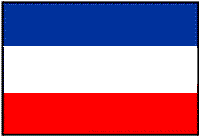




M-77 Oganj 128mm MLRS
VBR 128 "Oganj"
VBR 128 "Rak" M-9
SVLR 128mm M-77 "OGAN"
LRSV 128mm M-77Ababil-50 Work on this system began in 1968 and first prototypes were showen on the millitary parade in 1975, and production began in 1980. The system is mounted on the FAP-2026 6x6 configuration truck, with the trigering system activated 50 meters from the tube. It posseses 32 tubes, and reserve loading on the automatical charger another 32 missiles. The M-77 missile is a standard explosive warhead missile, weighting 67.10 kg, with the 19.53 kg warhead consisting of explosive TNT, Aluminium powder and Hexogen. In the M-77 missile warhead are 2562 103gr weight steel balls and 430 443gr weight steel balls. The missile speed is 750m/s. 32 missiles are covering elypse 167x213m. The new M-91 missile is a cluster type-warhead, consisting of 48 small bombs with cumulatiwe and fragmental action. The second type of cluster warhead consist 4 anti tank mines. M-77 MLRS was used in civill war in Yugoslavia, prooving its firepover and thrust.
Even though most of Iraq's missile production facilities received heavy damage during the Gulf War, Baghdad maintains some of the equipment needed to produce ballistic missiles, in part because of the dual-use nature of much of the equipment required for producing SCUDs. Today, Iraq's production efforts are focused on developing the Ababil-100, with an estimated maximum range of 150 kilometers, and the Ababil-50, a Yugoslav-designed 50-kilometer range battlefield artillery rocket that has been identified as derived from the M-77 Oganj 128mm MLRS.
Specifications
Range 21000 m Weight 22000 kg Secondary Armament Mashinegun 12.7 mm Colt-Browning on the cockpit rooof